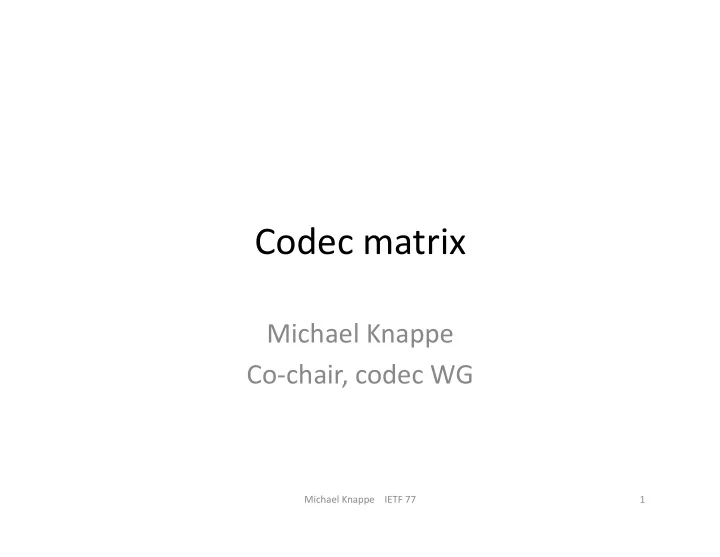

Codec matrix Michael Knappe Co‐chair, codec WG Michael Knappe IETF 77 1
Voice transmission Transducers / Amplifiers Transmission line Michael Knappe IETF 77 2
VoIP: Messaging vs. transmission Michael Knappe IETF 77 3
VoIP transmission PLC / Comfort VAD Noise Decode Encode TD EC EC Jitter buffer Synchronous Synchronous Asynchronous Michael Knappe IETF 77 4
InteracGve Quality Three orthogonal components Clarity • Quality define interactive audio quality – Clarity, latency, echo Echo • Clarity – More than intelligibility – “ease of use” – Factors incl. dist, noise, Latency freq resp, loudness – Scale of barely intelligible through ‘holographic’ Intelligible Natural Real codec WG 0.01- 1 100+ Relative BW scale: Michael Knappe IETF 77 5
Audio Transmission Nomenclature Sampling rate Usable bandwidth Narrowband 8 kHz 200 to 3400 Hz Wideband 16 kHz 50 to 7000 Hz Super wideband 32 kHz 50 to 14,000 Hz Fullband 44.1 kHz and up 20 to 20,000 Hz Useful comparisons: AM radio is limited to 5000 Hz audio FM radio is limited to 15,000 Hz audio CD is limited to 20,000 Hz audio Speed of sound in air: 343 m/s (approx 3 ms/m) Michael Knappe IETF 77 6
Audio frequencies http://www.podcomplex.com/images/ podcomplex-frequency-overview-chart.gif Michael Knappe IETF 77 7
Lossy Compression 101 • Source model based coding – Parameterizes source excitaGon, pitch and formants (a,e,i,o,u) – Generally Ged to human speech producGon mechanisms, with limited support for auditory perceptual weighGng – e.g. G.728, G.729 http://www.sungwh.freeserve.co.uk/sapienti/phon/headxsec.gif • Perceptual audio coding – Uses principals of psychoacousGcs and the human auditory system to dynamically assign the most bits to temporal and frequency characterisGcs most likely to be heard – e.g. MP3, AAC – Does an MP3 sound ok to a dog? http://www.skidmore.edu/~hfoley/images/AuditorySystem.jpg Michael Knappe IETF 77 8
SubjecGve TesGng MOS is both a method and metric for subjective quality scoring based on a five point rating system: MOS Quality Impairment 5 Excellent Imperceptible 4 Good Perceptible, but not annoying 3 Fair Slightly annoying 2 Poor Annoying 1 Bad Very annoying Compressed 4.5 – 5 range makes MOS not suitable for wideband+ quality determination MUSHRA ( MUltiple Stimuli with Hidden Reference and Anchor) with 0-100 scale and more compact statistical requirements better suited Michael Knappe IETF 77 9
ApplicaGon Drivers Applica8on Channels Bandwidth End to end Allowable Allowable bit‐ Latency complexity rate Speech 1 ‐ 2 NB ‐ WB <150 ms Low < 64 kbps Conference 1 ‐ 2 NB ‐ SWB AcGvity driven Medium < 128 kbps Telepresence 2+ SWB ‐ FB AcGvity driven High < 512 kbps Gaming 2+ SWB ‐ FB <150 ms High < 320 kbps Interac8ve 2 SWB ‐ FB < 25 ms Medium < 256 kbps music Content: even traditional phone calls handle signal types other than speech (e.g. music-on-hold), as a baseline we must assume non-specific audio content Other useful features: packet loss concealment, quality and bandwidth layering, joint multi-channel encoding Michael Knappe IETF 77 10
Narrowband matrix (8 kHz fs) Codec Bit rate Look Frame PSQM DTX PLC (kbps) ahead size (ms) (zero (ms) impair) G.711 64 0 Arbitr. 4.45 Appendix II Appendix I G.723.1 5.3, 6.3 7.5 30 3.6, 3.9 Yes Yes (MOS) G.728 16 0 0.562 3.6 (MOS) 8 5 10 4.04 Yes Yes G.729AB 4.75 – 5 20 4.14 Yes Yes AMR 12.2 GSM‐EFR 12.2 0 20 or 30 Yes iLBC 13.33, 0 20 or 30 4.14 Yes 15.2 (15.2) Sources: http://en.wikipedia.org/wiki/Comparison_of_audio_formats, Cable Labs PKT-SP-CODEC-MEDIA-I08-100120 Michael Knappe IETF 77 11
Wideband + Sample Bit rate Algorithm latency Comp # Chan PLC Codec rate (kHz) (kbps) (ms) Cmplx G.711.1 8, 16 64, 80 (8 kHz) 80, 11.875 1 96 (16 kHz) G.718 8, 16 8 ‐ 32 42.875 – 43.875 (20 1 Yes (extens.) ms frames) 48 32 ‐ 64 40 (20 ms frames) 18 FP‐ 1, MC G.719 MIPS (MP4) G.722 16 64 4 10 MIPS No G.722.1(C) 16, 32 (c) 24, 32, 48 (32) 40 (20 ms frames) 10 Yes WMOPS G.722.2 16 6.6 – 23.85 25 38 1, MC Yes WMOPS (MP4) (AMR‐WB) G.729.1 8, 16 8 ‐ 32 48.9375 Yes Siren 16 ‐ 48 16 (m) – 128 (s) 40 (20 ms frames) 1 or 2 Speex 8 ‐ 32 2 ‐ 44 30 NB, 34 WB 1, 2 opt. Yes AAC‐ELD ? ‐ 48? 24 ‐ 64 15 (64) – 32 ( 24) 1+ Yes Michael Knappe IETF 77 12
Summary • Goal 1: set codec applicaGon space ‐> define parameters of interest • Goal 2: survey current codecs and works‐in ‐progress • Goal 3: define benchmark tools and performance goals • Goal 4: qualify codecs, make choice(s) Michael Knappe IETF 77 13
Recommend
More recommend